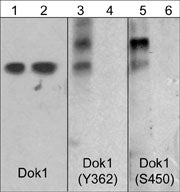Anti-Dok1 (Ser-450), Phosphospecific Antibody
- SPECIFICATION
- CITATIONS
- PROTOCOLS
- BACKGROUND

| Primary Accession | Q99704 |
|---|---|
| Reactivity | Bovine |
| Host | Rabbit |
| Clonality | Rabbit Polyclonal |
| Isotype | IgG |
| Clone Names | WB, E |
| Calculated MW | 52392 Da |
| Gene ID | 1796 |
|---|---|
| Other Names | p62DOK |
| Target/Specificity | Doks are a family of adaptor proteins that include six Dok proteins (Dok1 to Dok6), which have an N-terminal pleckstrin homology domain, a central phosphotyrosine binding domain, and a C-terminal region containing multiple tyrosine residues. When phosphorylated, these tyrosines can serve as docking sites for SH2 domain-containing proteins. Dok1 (p62dok) has been shown to bind Ras-GAP, Nck, and Csk. Several tyrosine phosphorylation sites have been identified for Dok1. One site, Tyr-362 (Tyr-361 mouse), is phosphorylated by c-Abl, is required for Nck binding, and may be critical for filopodia formation during fibroblast spreading on fibronectin. Alternatively, Dok1 activity is also regulated by serine phosphorylation. IκB Kinase β phosphorylates several serine sites including Ser-450 in vitro, and TNFα, IL-1, and radiation treatment lead to phosphorylation of Ser-443, Ser-446, and Ser-450 in vivo. Phosphorylation of these serine sites may be required for Dok-mediated inhibition of MAPK signaling and stimulation of cell motility. |
| Storage | Maintain refrigerated at 2-8°C for up to 6 months. For long term storage store at -20°C in small aliquots to prevent freeze-thaw cycles. |
| Precautions | Anti-Dok1 (Ser-450), Phosphospecific Antibody is for research use only and not for use in diagnostic or therapeutic procedures. |
| Shipping | Blue Ice |

Thousands of laboratories across the world have published research that depended on the performance of antibodies from Abcepta to advance their research. Check out links to articles that cite our products in major peer-reviewed journals, organized by research category.
info@abcepta.com, and receive a free "I Love Antibodies" mug.
Provided below are standard protocols that you may find useful for product applications.
Background
Doks are a family of adaptor proteins that include six Dok proteins (Dok1 to Dok6), which have an N-terminal pleckstrin homology domain, a central phosphotyrosine binding domain, and a C-terminal region containing multiple tyrosine residues. When phosphorylated, these tyrosines can serve as docking sites for SH2 domain-containing proteins. Dok1 (p62dok) has been shown to bind Ras-GAP, Nck, and Csk. Several tyrosine phosphorylation sites have been identified for Dok1. One site, Tyr-362 (Tyr-361 mouse), is phosphorylated by c-Abl, is required for Nck binding, and may be critical for filopodia formation during fibroblast spreading on fibronectin. Alternatively, Dok1 activity is also regulated by serine phosphorylation. IκB Kinase β phosphorylates several serine sites including Ser-450 in vitro, and TNFα, IL-1, and radiation treatment lead to phosphorylation of Ser-443, Ser-446, and Ser-450 in vivo. Phosphorylation of these serine sites may be required for Dok-mediated inhibition of MAPK signaling and stimulation of cell motility.
If you have used an Abcepta product and would like to share how it has performed, please click on the "Submit Review" button and provide the requested information. Our staff will examine and post your review and contact you if needed.
If you have any additional inquiries please email technical services at tech@abcepta.com.













 Foundational characteristics of cancer include proliferation, angiogenesis, migration, evasion of apoptosis, and cellular immortality. Find key markers for these cellular processes and antibodies to detect them.
Foundational characteristics of cancer include proliferation, angiogenesis, migration, evasion of apoptosis, and cellular immortality. Find key markers for these cellular processes and antibodies to detect them. The SUMOplot™ Analysis Program predicts and scores sumoylation sites in your protein. SUMOylation is a post-translational modification involved in various cellular processes, such as nuclear-cytosolic transport, transcriptional regulation, apoptosis, protein stability, response to stress, and progression through the cell cycle.
The SUMOplot™ Analysis Program predicts and scores sumoylation sites in your protein. SUMOylation is a post-translational modification involved in various cellular processes, such as nuclear-cytosolic transport, transcriptional regulation, apoptosis, protein stability, response to stress, and progression through the cell cycle. The Autophagy Receptor Motif Plotter predicts and scores autophagy receptor binding sites in your protein. Identifying proteins connected to this pathway is critical to understanding the role of autophagy in physiological as well as pathological processes such as development, differentiation, neurodegenerative diseases, stress, infection, and cancer.
The Autophagy Receptor Motif Plotter predicts and scores autophagy receptor binding sites in your protein. Identifying proteins connected to this pathway is critical to understanding the role of autophagy in physiological as well as pathological processes such as development, differentiation, neurodegenerative diseases, stress, infection, and cancer.


